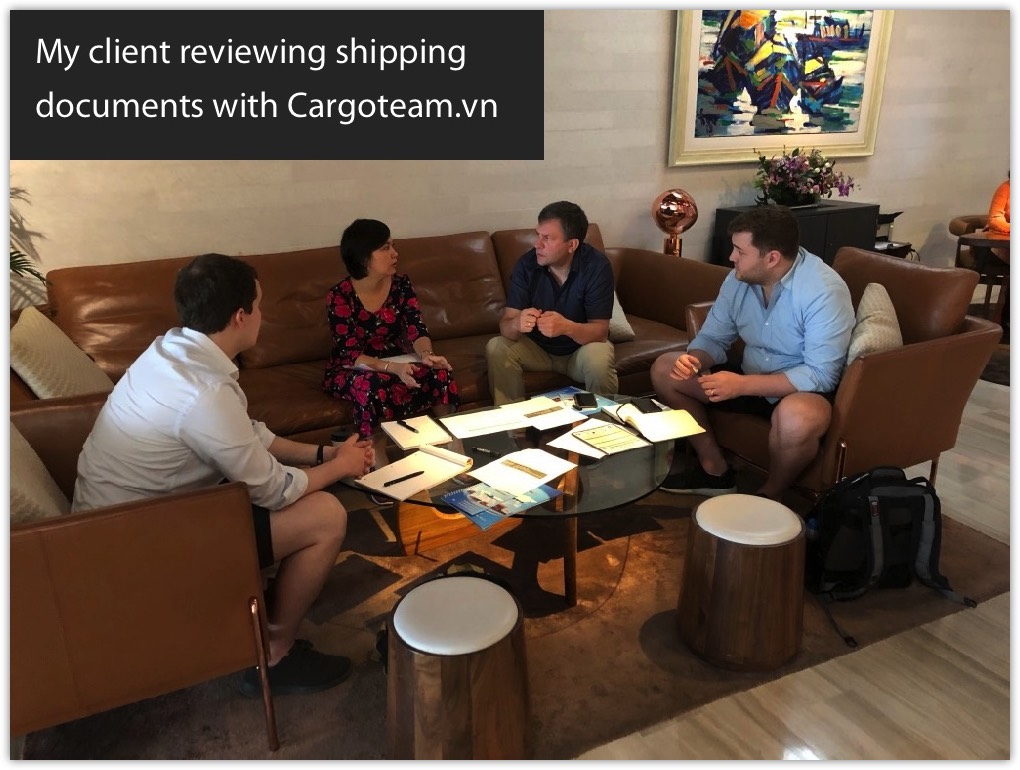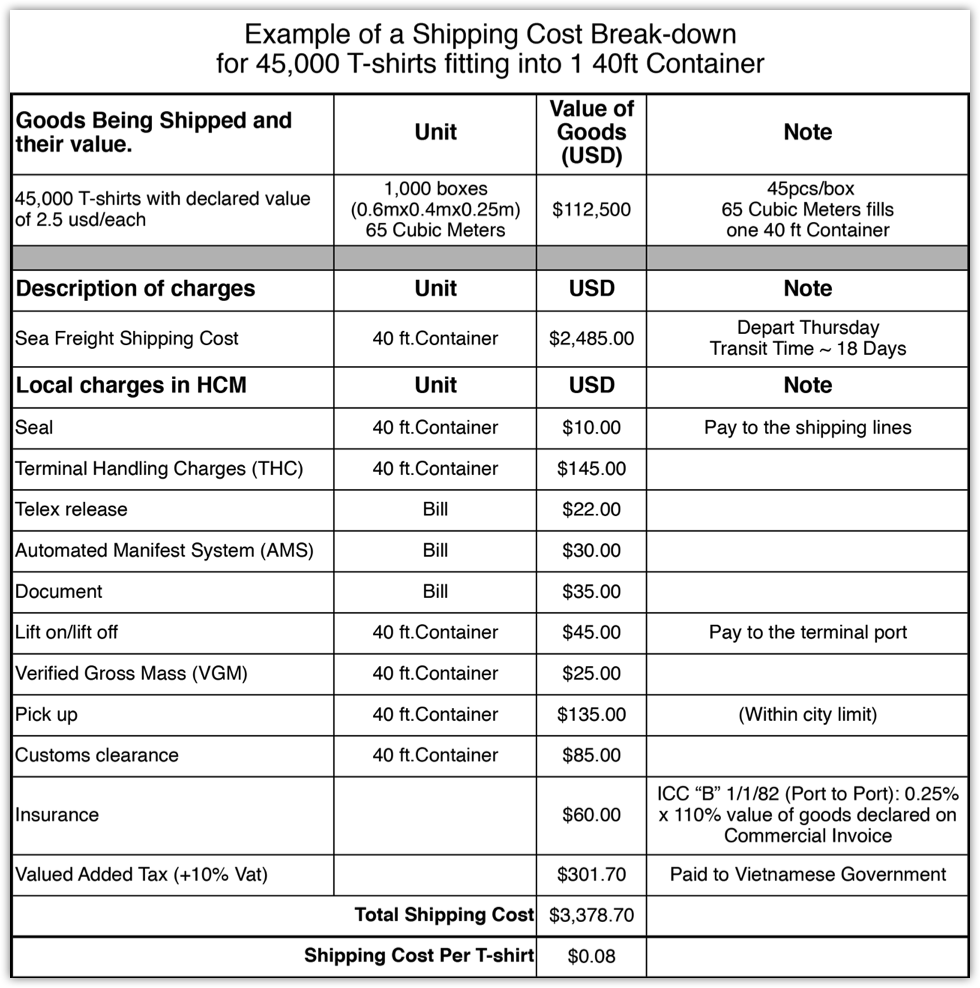Shipping Documents You Need to Know
• Air waybills for Air Shipments
• Ocean Waybill for Ocean Shipments
• Bill of lading
• Commercial invoice
• Consular invoice
• Certificate of origin
• Dock receipt and a warehouse receipt
• Destination control statement
• Shipper's Export Declaration (SED)
• Export license
• Export packing list
• Insurance certificate
Watch my introduction video and read below to learn more about shipping documents you need to know if you want to produce in Vietnam and ship overseas.
• Ocean Waybill for Ocean Shipments
• Bill of lading
• Commercial invoice
• Consular invoice
• Certificate of origin
• Dock receipt and a warehouse receipt
• Destination control statement
• Shipper's Export Declaration (SED)
• Export license
• Export packing list
• Insurance certificate
Watch my introduction video and read below to learn more about shipping documents you need to know if you want to produce in Vietnam and ship overseas.
Services We Offer
eBooks
Courses
Consultation
Factory Introductions
Factory Tours
Production A to Z
When is a good time to schedule a time to talk?
Please fill in our contact form below,
then click the submit button.
See you in Vietnam!
What shipping documents do you need to ship out of Vietnam?
This page is about Shipping Documents to Import Clothes
Below is a list of shipping documents to import clothes into Vietnam that are needed to clear customs. This is not a comprehensive list, nor does it apply to your specific shipment scenario. The aim is to appreciate the amount of work that goes into preparing shipping documents. Your shipping company will work with you to prepare them.
Below is a list of shipping documents to import clothes into Vietnam that are needed to clear customs. This is not a comprehensive list, nor does it apply to your specific shipment scenario. The aim is to appreciate the amount of work that goes into preparing shipping documents. Your shipping company will work with you to prepare them.

Schedule a Factory Tour Today!



Before we learn about each form, I recommend that you memorize some of these shipping documents to import clothes into Vietnam. Take 20 minutes now to understand and memorize them so that when you meet with a freight forwarded you don’t get overwhelmed. In business, “a deer in the headlights look” makes you vulnerable. I want to help you feel and sound confident.
Vocabulary you will need to know:
Importer of Record can be any one of the following entities: owner, purchaser, or licensed customs broker designated by the owner, or consignee. The Importer of Record is responsible for paying the duty on the goods. Your shipping company will explain the advantages and disadvantages of choosing the Importer of Record.
Imported goods are not legally entered until after the shipment has arrived within the port of entry, delivery of the merchandise has been authorized by U.S. Customs and Border Protection office (CBP,) and estimated duties have been paid. It is the importer of record's responsibility to arrange for examination and release of the goods.
Consigning is the act of giving over to another person or company, custody of goods, but retaining legal ownership until the goods are delivered. So, while your garments are in transit, you, the consigner, temporarily give “ownership” to the consignee. The consignee is the shipping company. Once the shipment is complete and goods are received in your warehouse, the consignee “returns” your goods to you. You will encounter these terms on many shipping documents.
Lading is the act of loading cargo shipments on board a vessel for transportation to the United States. Port of lading is where the goods are initially loaded on the vessel. Port of unlading is the where the goods are unloaded from the vessel.
Bill of Lading is a document providing the vessel captain and the carrier all the details needed to process the freight shipment and invoice it correctly. It contains a detailed list of the containers’ content.
Imported goods are not legally entered until after the shipment has arrived within the port of entry, delivery of the merchandise has been authorized by U.S. Customs and Border Protection office (CBP,) and estimated duties have been paid. It is the importer of record's responsibility to arrange for examination and release of the goods.
Consigning is the act of giving over to another person or company, custody of goods, but retaining legal ownership until the goods are delivered. So, while your garments are in transit, you, the consigner, temporarily give “ownership” to the consignee. The consignee is the shipping company. Once the shipment is complete and goods are received in your warehouse, the consignee “returns” your goods to you. You will encounter these terms on many shipping documents.
Lading is the act of loading cargo shipments on board a vessel for transportation to the United States. Port of lading is where the goods are initially loaded on the vessel. Port of unlading is the where the goods are unloaded from the vessel.
Bill of Lading is a document providing the vessel captain and the carrier all the details needed to process the freight shipment and invoice it correctly. It contains a detailed list of the containers’ content.

Brief Description of Shipping Documents to Import Clothes into Vietnam
Air waybills for Air Shipments or Ocean waybills…
A waybill is a document issued by a carrier, giving details and instructions relating to the shipment of a consignment of goods. Typically it will show the names of the consignor and consignee, the point of origin of the consignment, its destination, and route.
Bill of lading
A bill of lading is a contract between the owner of the goods and the carrier. When the freight is laden on board at origin, the original bill of lading is produced and provided to the shipper. The shipment cannot be released to the consignee at destination as long as the shipper holds that original bill of lading. At some point, the shipper will release their hold on the cargo, usually once the shipper has been paid, and the original is sent to the importer by courier. At that point, it can be presented to the shipping company at destination to secure the release of the freight.
Commercial invoice
A commercial invoice is a bill for the goods, from the seller to the buyer. Governments use commercial invoices to determine the true value of goods when assessing customs duties.
Consular invoice
A consular invoice is a document that is required in some countries. It describes the shipment of goods and shows information such as the consignor, consignee, and value of the shipment. Consular invoices are certified by the consular official, working in Vietnam. The US customs officials use the consular invoices to verify the value, quantity, and nature of the shipment.
Certificate of origin
A certificate of origin is a document that is required in certain nations. It is a signed statement as to the origin of the export item. Certificate of origin is usually signed through a semi-official organization, such as a local chamber of commerce.
Dock receipt and a warehouse receipt
They are documents issued by a shipping company to acknowledge that goods have been received for shipment. Dock receipts transfer the accountability for the safe custody of the cargo from the shipper to the carrier, and serves as the basis for preparing the bill of lading.
Shipper's Export Declaration (SED)
A SED is used to control exports and act as a source document for official U.S. export statistics.
Export license
An export license is a government document that authorizes the export of specific goods in specific quantities to a particular destination. This document may be required for most or all exports to some countries, or for other countries only under special circumstances.
Export packing list
An export packing-list is more detailed and informative than a standard domestic packing list. It itemizes the material in each individual package and indicates the type of package, such as a box, crate, drum, or carton. It also shows the individual net, legal, tare, gross weights and measurements for each package (in both U.S. and metric systems). Package markings should be shown, along with the shipper and buyer's references. The list is used by the shipper or forwarding agent to determine the total shipment weight and volume, and whether the correct cargo is being shipped.
These are some Shipping Documents to Import Clothes into Vietnam that you will learn about when working with freight forwarder.
Insurance certificate
An insurance certificate is used to assure the consignee that insurance will cover the loss of, or damage to, the cargo during transit.
In Conclusion: the freight forwarder and factory will prepare all the documentation and protect you - for a fee. My advice is to be informed and prepare to answer shipping questions that your freight forwarder and factory will ask you. Equally important is to shop around for a friendly and professional freight forwarding company that gives you genuine and thorough customer service. There will be a steep learning curve for you the first time you import from Vietnam.